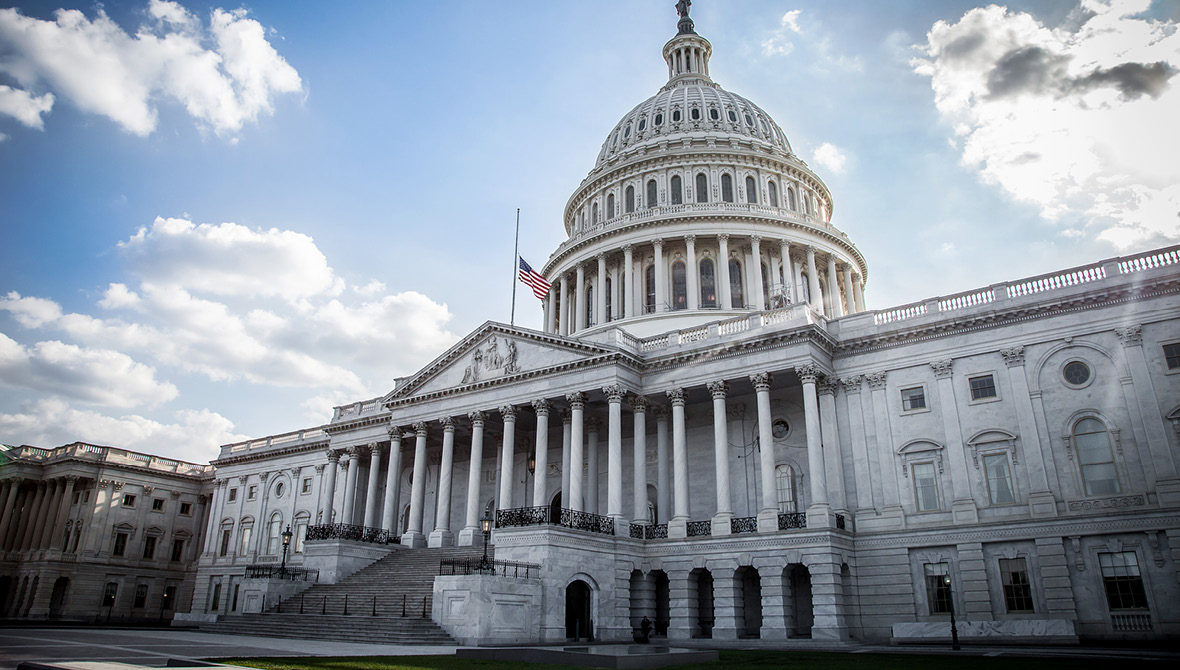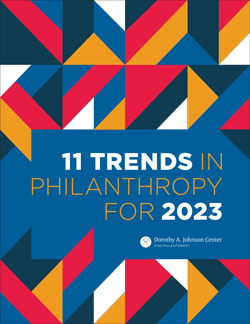Policymakers are Paying Increasing Attention to Moving More Money Faster


 This article was first published in our 11 Trends in Philanthropy for 2023 report. Explore all 11 trends in the report.
This article was first published in our 11 Trends in Philanthropy for 2023 report. Explore all 11 trends in the report.While the wealth gap in the U.S. has been widening for decades, conversations about that wealth, the rise of billionaires, and growing income inequality broke into the mainstream of public attention through the Occupy Wall Street movement in the fall of 2011 (Volle, 2022).
Today, parallel conversations within the philanthropic sector tend to be focused on the funding landscape. Across the last 10–15 years, we’ve seen increased attention to foundation payout rates, the declining number of individual donors, and the growth of donor-advised funds (DAFs). The common thread in those conversations is an increasingly frequent discussion about moving more money from funders to operating nonprofits — and moving it more quickly along that path.
“[D]uring the 2009-2010 Congressional session, fewer than five bills specifically referenced DAFs. By the 2017-2018 session, that number increased to 15; in 2019-2020, the number increased again to 21.”
This trend is best understood as a reprise of conversations that have happened before — and a conversation that has multiple perspectives. The new shift is in the role Congress seems eager to play.
In 2010, at the same time that Occupy Wall Street was capturing the public’s attention, two related movements to encourage wealthy donors and foundations to give more were starting up:
Patriotic Millionaires was founded to advocate for ending the Bush-era tax cuts for wealthy Americans (n.d.). By 2020, Patriotic Millionaires had joined with other advocates to push Congress to raise the private foundation payout requirements from 5% of assets to 10% for three years, primarily in response to the COVID-19 pandemic (Daniels, 2020).
The second half of the 2010s saw a series of public speeches, white papers, and books on the same subject. The starting gun sounded with Anand Giridharadas’ provocative speech to the Aspen Institute in July 2015, “The Thriving World, the Wilting World, and You,” followed by his book Winners Take All in 2018.
Darren Walker of the Ford Foundation wrote “Toward a New Gospel of Wealth” in 2015 as well; his follow-up book publishes in 2023. Other voices published soon after: David Callahan’s The Givers: Wealth, Power, and Philanthropy in a New Gilded Age appeared in 2017; and 2018 saw both Rob Reich’s book, Just Giving: Why Philanthropy Is Failing Democracy and How It Can Do Better, and an August article in The New Yorker, “Gospels of Giving for the New Gilded Age” (Kolbert).
These voices elevated a discussion — accelerated by the pandemic — that created another set of nonprofit advocates. The Crisis Charitable Commitment launched in 2020, seeking to “double the amount of charitable dollars going to nonprofits without creating an unreasonable burden on the donor” (para. 2). Their four-part strategy centered around a call for Congress to include an emergency charitable stimulus in the omnibus COVID-19 relief legislation, a commitment from donors to commit 1% of their assets to democracy-related organizations, more widespread adoption of the Giving Pledge by billionaires, and renewed consideration of a national wealth tax.
#HalfMyDAF also launched in 2020. Like the Giving Pledge, #HalfMyDAF sought public commitments from DAF holders to donate half of their DAF balances to operating nonprofits by September 30 of that year.
Many foundations have taken steps to move more money faster in a variety of ways. Walker’s essay and related advocacy work from the Philanthropy Roundtable (Florino, 2022) both highlighted these proactive steps. Walker’s Ford Foundation led a unique effort in 2020 (joined by four other major grantmakers) to issue investment-backed bonds to enable them to immediately increase their payouts (Kavate, 2020). And a global survey by Rockefeller Philanthropy Advisors and NORC at the University of Chicago (2020) found that, while perpetuities remained the clear first choice, “more than two in five (44%) of the organizations established in the 2010s were set up as time-limited entities” (p. 9).
That said, it is important to note that the debate about moving money differently within the sector is still a debate — and it’s not a new one. Cursory Google searches show that conversations about the trade-offs inherent in time-limited versus perpetual foundations could be found in The New York Times in 2009 (Johnston), and in “how to” guides for managing spend-down foundations from the Philanthropy Roundtable in 2002 (Piereson). No consensus exists as to whether one strategy is more impactful than the other.
On the regulatory front, private foundations did not have a minimum payout rate until the Tax Reform Act of 1969 set it at 6%; an amendment in 1981 created the current 5% minimum threshold (Kavate, 2020). Alternative views on payout rates, perpetual foundations, or both can be found in documents such as Beyond Five Percent: The New Foundation Payout Menu from the Beldon Fund and partners (Waleson, 2007) or the Stanford Social Innovation Review article, “A ‘Balancing Test’ for Foundation Spending” (Abichandani, 2020). Articles from Council on Foundations (n.d.a), Philanthropy Roundtable (Florino, 2021, 2022), and Independent Sector (2021) explore the potential downsides of a mandated increase and even enthusiastically support maintaining the 5% rule.
So, if these discussions are not new, and they are not settled, why call this a trend? Because one extremely important entity is also taking an increased interest in philanthropy over the last ten years: the U.S. Congress.
During the pandemic, Congress sought to bolster philanthropic giving with a special carve-out in the CARES Act (2020), temporarily adding a charitable deduction for all filers, regardless of itemization status.
Other efforts focused more on regulation. For example, during the 2009-2010 Congressional session, fewer than five bills specifically referenced DAFs. By the 2017-2018 session, that number increased to 15; in 2019-2020, the number increased again to 21.
In the most recent Congressional session (2021-2022), Sen. Angus King (I-ME) introduced the Accelerating Charitable Efforts (ACE) Act. Although the ACE Act died in committee with the end of the 117th Congress, its proposed changes could be sweeping. The ACE Act would set minimum payout rates for DAFs (Council on Foundations, n.d.b) and introduce the idea of changing the immediate tax benefits to donors regardless of when monies are distributed onward to operating nonprofits, among other provisions. Many observers expect continued interest and discussion in the new Congress on similar topics.
Both within the sector and without, this increasing attention to moving more money faster is about the role of philanthropy in civil society in general — and the role of philanthropy in responding to the Great Recession and the COVID-19 pandemic, in particular. Though the pressure for philanthropy to spend more, and more quickly, is more likely to increase than decrease, the proper policy response to those calls and the mechanics of those changes — and their unintended follow-on consequences — remain very unclear.
Abichandi, D. (2020). A ‘Balancing Test’ for foundation spending. Stanford Social Innovation Review. https://doi.org/10.48558/JAY0-9A73
ACE Act, S.1981. (2021). https://www.congress.gov/bill/117th-congress/senate-bill/1981/all-info
Callahan, D. (2017). The givers: Wealth, power, and philanthropy in a new gilded age. Alfred A. Knopf.
CARES Act, 15 U.S.C. 9001. (2020, March 27). https://www.govinfo.gov/content/pkg/PLAW-116publ136/pdf/PLAW-116publ136.pdf
Council on Foundations. (n.d.a) Policy brief: Foundation payout and the COVID-19 crisis. https://cof.org/content/policy-brief-foundation-payout-and-covid-19-crisis
Council on Foundations. (n.d.b). Summary of Accelerating Charitable Efforts Act (“ACE Act”). https://cof.org/content/summary-accelerating-charitable-efforts-act-ace-act
Crisis Charitable Commitment. (2020). About. https://charitablecommitment.org/about-us/
Daniels, A. (2020, May 20). Nearly 300 donors and grant makers join push to require philanthropic funds to give more now. Chronicle of Philanthropy. https://www.philanthropy.com/article/nearly-300-donors-and-grant-makers-join-push-to-require-philanthropic-funds-to-give-more-now
Florino, J. (2021, January 14). Foundation payout decisions and the folly of one-size-fits-all mandates. Philanthropy Roundtable. https://www.philanthropyroundtable.org/foundation-payout-decisions-and-the-folly-of-one-size-fits-all-mandates/
Florino, J. (2022, July 29). Why increasing foundation payout requirements is the wrong approach. Philanthropy Roundtable. https://www.philanthropyroundtable.org/why-increasing-foundation-payout-requirements-is-the-wrong-approach/
Giridharadas, A. (2015, July 31). The thriving world, the wilting world, and you. https://medium.com/@AnandWrites/the-thriving-world-the-wilting-world-and-you-209ffc24ab90
Giridharadas, A. (2018, August 28). Winners take all: The elite charade of changing the world. Alfred A. Knopf.
The Giving Pledge. (n.d.a). About the Giving Pledge. https://givingpledge.org/about
The Giving Pledge. (n.d.b). A commitment to philanthropy. https://givingpledge.org
The Giving Pledge. (2022). Frequently asked questions. https://www.givingpledge.org/faq/
#HalfMyDaf. (2022). About. https://www.halfmydaf.com/about
Independent Sector. (2021, November 19). What we’ve heard at our first three ACE Act convenings. https://independentsector.org/blog/what-weve-heard-at-our-first-three-ace-act-convenings/
Johnston, D. C. (2009, November 11). As foundations close, anxiety for charities. The New York Times. https://www.nytimes.com/2009/11/12/giving/12SPEND.html
Kavate, M. (2020, June 19). Inside the foundation payout debate: How crisis and opportunity are forcing change. Inside Philanthropy. https://www.insidephilanthropy.com/home/2020/6/19/for-decades-foundations-have-given-the-minimum-required-that-may-be-changing
Kolbert, E. (2018, August 20). Gospels of giving for the new gilded age. The New Yorker. https://www.newyorker.com/magazine/2018/08/27/gospels-of-giving-for-the-new-gilded-age
Patriotic Millionaires. (n.d.) About us. https://patrioticmillionaires.org/about/
Piereson, J. (2002). The insider’s guide to spend down. Philanthropy Roundtable. https://www.philanthropyroundtable.org/magazine/the-insiders-guide-to-spend-down/
Reich, R. (2018, November 20). Just giving: Why philanthropy is failing democracy and how it can do better. Princeton University Press.
Rockefeller Philanthropy Advisors, & NORC at the University of Chicago. (2020, January). Strategic time horizons: A global snapshot of foundation approaches. https://www.rockpa.org/wp-content/uploads/2020/01/Strategic-Time-Horizons-a-Global-Snapshot-of-Foundation-Approaches_FNL.pdf
Volle, A. (2022, November 9). Occupy Wall Street. Britannica. https://www.britannica.com/topic/Occupy-Wall-Street
Waleson, H. (2007, January 1). Beyond five percent: The new foundation payout menu. French American Charitable Trust, Northern California Grantmakers, and the New York Regional Association of Grantmakers. http://www.beldon.org/beyond5_report.pdf
Walker, D. (2015, October 1). Toward a new gospel of wealth. Ford Foundation. https://www.fordfoundation.org/news-and-stories/stories/posts/toward-a-new-gospel-of-wealth